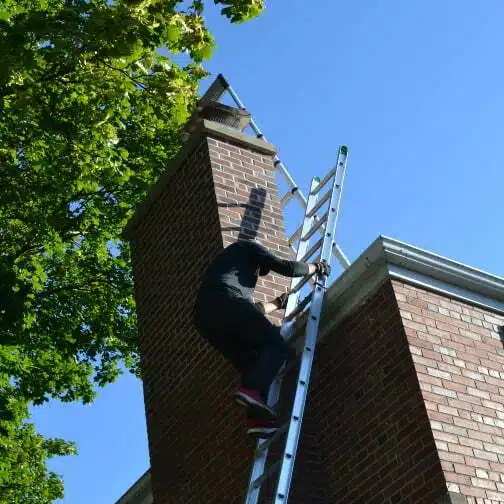chimney FAQ
How Can I Fix Cracked Flue Tiles In My Chimney?
Short Answer: To fix cracked flue tiles in your chimney, consult a professional chimney repair service to assess the damage and recommend the best solution. Common repair methods include flue tile replacement, chimney relining with stainless steel or cast-in-place liners, or applying a HeatShield® sealant.

A well-functioning chimney is crucial for the safety and efficiency of your home’s heating system. However, one common issue that homeowners face is cracked flue tiles. These cracks can lead to dangerous situations, such as increased risk of chimney fires and carbon monoxide poisoning.
Fortunately, Lindeman has over 50 years of experience diagnosing and fixing chimneys for our customers in the Chicagoland area. We’ll discuss how to identify cracked flue tiles, the reasons behind these cracks, repair options, and preventive measures to maintain a safe and efficient chimney.
Identifying Cracked Flue Tiles
When determining whether or not your chimney flue is damaged, you should check for some of the common signs of cracked flue tiles. Some of these signs include:
- Visible cracks: Inspect the interior of your chimney for visible cracks in the flue tiles. This can be done using a flashlight or a mirror.
- Smoke leakage: If you notice smoke seeping into your living space, it may indicate a crack in the flue tiles.
- Creosote buildup: Excessive creosote buildup in the chimney can be a sign of damaged flue tiles, as creosote can seep through the cracks.
While you can look for some signs of cracked flue tiles yourself, it’s essential to have a professional chimney sweep inspect your chimney. They can use video inspection technology to get a more in-depth look at the condition of your flue tiles and identify any issues that may not be visible to the naked eye.
Reasons for Cracked Flue Tiles
Unfortunately, there are many possible causes for flue tiles to become cracked or damaged. In order to determine if cracks exist, it may help to know what the possible causes are. Here are some of the most common reasons that flue tiles become cracked:
- Thermal stress: Extreme temperature changes inside the chimney can cause flue tiles to expand and contract, leading to cracks.
- Moisture damage: Water entering the chimney can freeze and expand, causing cracks in the flue tiles.
- Chimney fires: Intense heat from a chimney fire can cause flue tiles to crack or shatter.
- Improper installation: Poorly installed flue tiles can lead to cracks over time.
Repair Options for Cracked Flue Tiles
If it is determined that your chimney has cracked flue tiles, then they must be repaired. There are two options for repair: flue tile replacement or complete chimney relining.
Flue tile replacement
Cracked flue tiles can be repaired using a variety of methods. When choosing the best option for your chimney, consider factors such as the extent of the damage, your budget, and the age of your chimney. The following are some common repair options:
- Process overview: The damaged flue tiles are carefully removed and replaced with new ones. This process typically involves dismantling the surrounding masonry or chimney structure to access the damaged tiles. Once the new tiles are in place, the chimney is reconstructed and sealed.
- Pros and cons: Flue tile replacement can be an effective solution for severely damaged flue tiles. However, it can be labor-intensive, time-consuming, and costly. Additionally, this method may not be suitable for older chimneys with extensive damage, as the entire chimney may need rebuilding.
Chimney relining
Chimney relining involves installing a new liner inside the existing chimney, effectively creating a new, smooth, and insulated flue system. There are several types of chimney liners available:
- Stainless steel liners: Installing a stainless steel liner inside the existing chimney can provide a durable and long-lasting solution for cracked flue tiles.
- Cast-in-place liners: A cast-in-place liner involves pouring a cement-like material into the chimney, creating a seamless and insulated liner.
- HeatShield® system: This repair method involves applying a cerfractory sealant to the damaged flue tiles, sealing the cracks and restoring the chimney’s functionality.
It’s essential to consult a professional chimney repair service such as the professionals at Lindemann in order to determine the best repair method for your specific situation.
Preventing Future Crack In Your Chimney Flue Tiles
The best thing you can do for your chimney in order to minimize the repairs needed in the future is to properly maintain it. This way you can prevent future cracks in your chimney flue tiles, keep your family safe, and save you money in the long term. Here is how you can do so:
- Regular chimney inspections: Schedule annual inspections by a certified chimney sweep to identify and address any issues early on.
- Chimney cleaning and maintenance: Regularly clean your chimney to prevent creosote buildup, reducing the risk of chimney fires.
- Use of chimney caps: Install a chimney cap to prevent water and debris from entering your chimney, minimizing moisture damage.
- Waterproofing your chimney: Apply a waterproof sealant to the exterior of your chimney to protect it from water damage.
Conclusion
Addressing cracked flue tiles is essential for the safety and efficiency of your home’s heating system. By selecting the best repair method and committing to regular chimney maintenance, you can prevent future issues and ensure your chimney remains in optimal working condition.
Regardless of how you choose to address a cracked tile problem, hiring a professional sweep to do the work is important. We have the expertise and knowledge to complete the often complex lining process while also ensuring the chimney is compliant with local fire codes. For Chicago area homeowners, Lindemann Chimney Service is the trusted partner they turn to for all of your chimney needs.
